JEEP WRANGLER 2021 Owner handbook (in English)
Manufacturer: JEEP, Model Year: 2021, Model line: WRANGLER, Model: JEEP WRANGLER 2021Pages: 276, PDF Size: 4.47 MB
Page 101 of 276
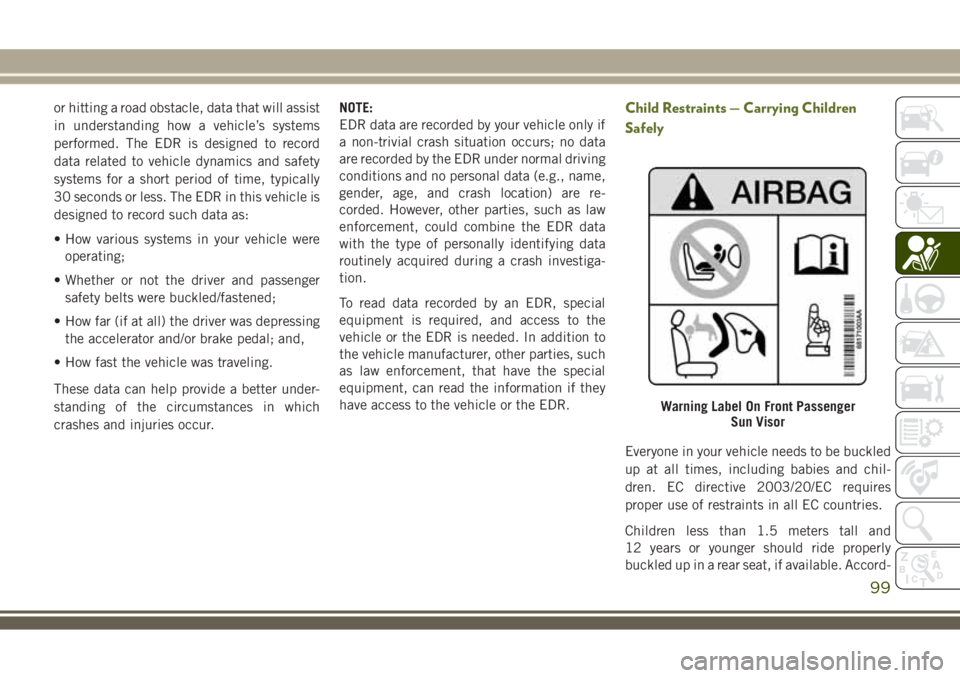
or hitting a road obstacle, data that will assist
in understanding how a vehicle’s systems
performed. The EDR is designed to record
data related to vehicle dynamics and safety
systems for a short period of time, typically
30 seconds or less. The EDR in this vehicle is
designed to record such data as:
• How various systems in your vehicle were
operating;
• Whether or not the driver and passenger
safety belts were buckled/fastened;
• How far (if at all) the driver was depressing
the accelerator and/or brake pedal; and,
• How fast the vehicle was traveling.
These data can help provide a better under-
standing of the circumstances in which
crashes and injuries occur.NOTE:
EDR data are recorded by your vehicle only if
a non-trivial crash situation occurs; no data
are recorded by the EDR under normal driving
conditions and no personal data (e.g., name,
gender, age, and crash location) are re-
corded. However, other parties, such as law
enforcement, could combine the EDR data
with the type of personally identifying data
routinely acquired during a crash investiga-
tion.
To read data recorded by an EDR, special
equipment is required, and access to the
vehicle or the EDR is needed. In addition to
the vehicle manufacturer, other parties, such
as law enforcement, that have the special
equipment, can read the information if they
have access to the vehicle or the EDR.Child Restraints — Carrying Children
Safely
Everyone in your vehicle needs to be buckled
up at all times, including babies and chil-
dren. EC directive 2003/20/EC requires
proper use of restraints in all EC countries.
Children less than 1.5 meters tall and
12 years or younger should ride properly
buckled up in a rear seat, if available. Accord-
Warning Label On Front Passenger
Sun Visor
99
Page 102 of 276
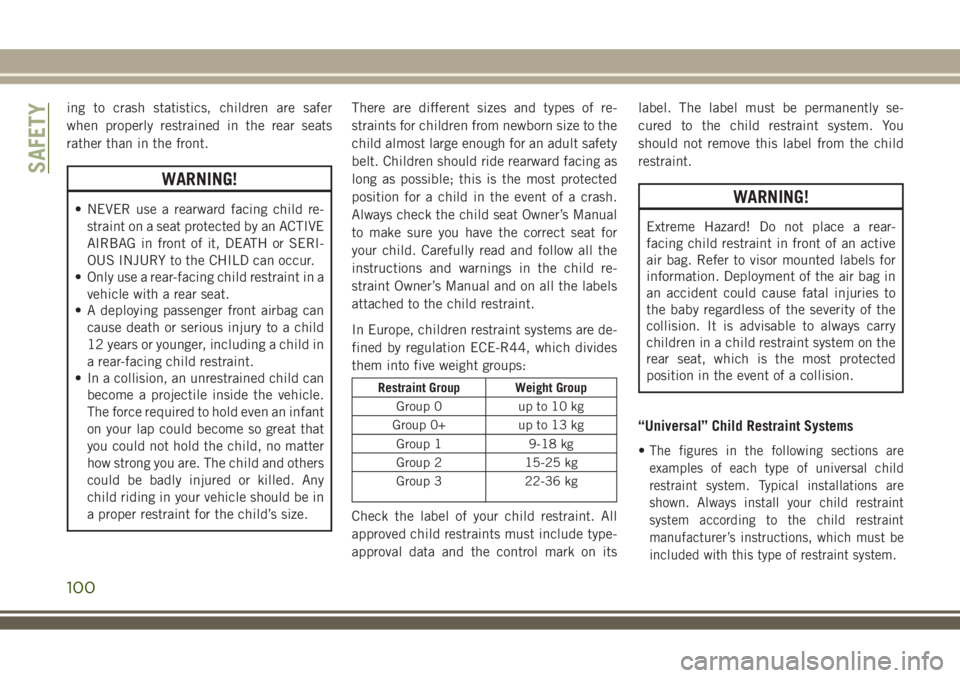
ing to crash statistics, children are safer
when properly restrained in the rear seats
rather than in the front.
WARNING!
• NEVER use a rearward facing child re-
straint on a seat protected by an ACTIVE
AIRBAG in front of it, DEATH or SERI-
OUS INJURY to the CHILD can occur.
• Only use a rear-facing child restraint in a
vehicle with a rear seat.
• A deploying passenger front airbag can
cause death or serious injury to a child
12 years or younger, including a child in
a rear-facing child restraint.
• In a collision, an unrestrained child can
become a projectile inside the vehicle.
The force required to hold even an infant
on your lap could become so great that
you could not hold the child, no matter
how strong you are. The child and others
could be badly injured or killed. Any
child riding in your vehicle should be in
a proper restraint for the child’s size.There are different sizes and types of re-
straints for children from newborn size to the
child almost large enough for an adult safety
belt. Children should ride rearward facing as
long as possible; this is the most protected
position for a child in the event of a crash.
Always check the child seat Owner’s Manual
to make sure you have the correct seat for
your child. Carefully read and follow all the
instructions and warnings in the child re-
straint Owner’s Manual and on all the labels
attached to the child restraint.
In Europe, children restraint systems are de-
fined by regulation ECE-R44, which divides
them into five weight groups:
Restraint Group Weight Group
Group 0 up to 10 kg
Group 0+ up to 13 kg
Group 1 9-18 kg
Group 2 15-25 kg
Group 3 22-36 kg
Check the label of your child restraint. All
approved child restraints must include type-
approval data and the control mark on itslabel. The label must be permanently se-
cured to the child restraint system. You
should not remove this label from the child
restraint.
WARNING!
Extreme Hazard! Do not place a rear-
facing child restraint in front of an active
air bag. Refer to visor mounted labels for
information. Deployment of the air bag in
an accident could cause fatal injuries to
the baby regardless of the severity of the
collision. It is advisable to always carry
children in a child restraint system on the
rear seat, which is the most protected
position in the event of a collision.
“Universal” Child Restraint Systems
•The figures in the following sections are
examples of each type of universal child
restraint system. Typical installations are
shown. Always install your child restraint
system according to the child restraint
manufacturer’s instructions, which must be
included with this type of restraint system.
SAFETY
100
Page 103 of 276
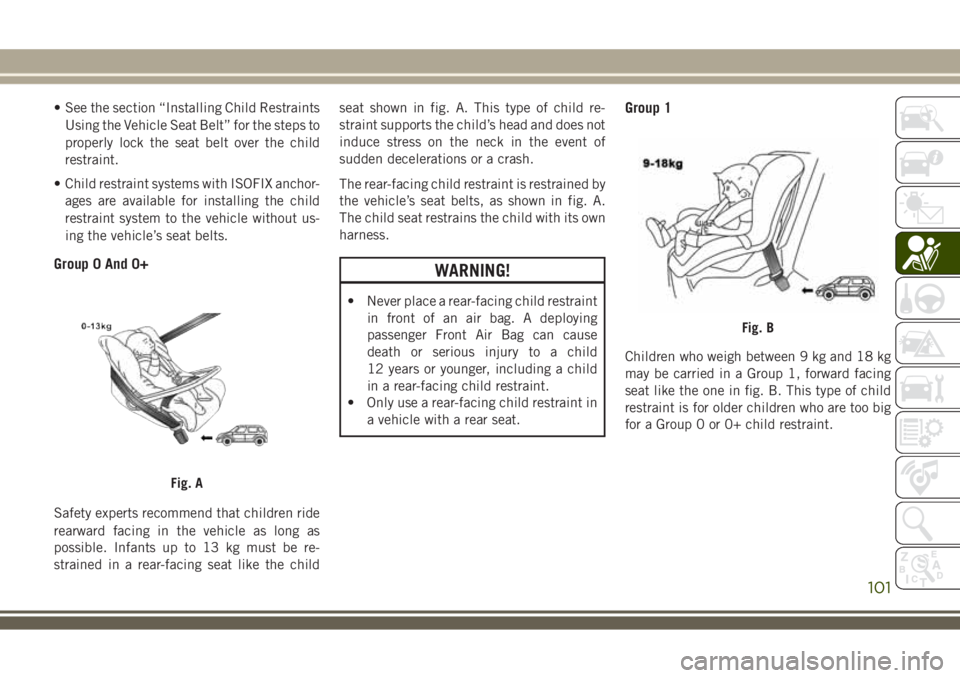
• See the section “Installing Child Restraints
Using the Vehicle Seat Belt” for the steps to
properly lock the seat belt over the child
restraint.
• Child restraint systems with ISOFIX anchor-
ages are available for installing the child
restraint system to the vehicle without us-
ing the vehicle’s seat belts.
Group 0 And 0+
Safety experts recommend that children ride
rearward facing in the vehicle as long as
possible. Infants up to 13 kg must be re-
strained in a rear-facing seat like the childseat shown in fig. A. This type of child re-
straint supports the child’s head and does not
induce stress on the neck in the event of
sudden decelerations or a crash.
The rear-facing child restraint is restrained by
the vehicle’s seat belts, as shown in fig. A.
The child seat restrains the child with its own
harness.
WARNING!
• Never place a rear-facing child restraint
in front of an air bag. A deploying
passenger Front Air Bag can cause
death or serious injury to a child
12 years or younger, including a child
in a rear-facing child restraint.
• Only use a rear-facing child restraint in
a vehicle with a rear seat.
Group 1
Children who weigh between 9 kg and 18 kg
may be carried in a Group 1, forward facing
seat like the one in fig. B. This type of child
restraint is for older children who are too big
for a Group 0 or 0+ child restraint.
Fig. A
Fig. B
101
Page 104 of 276
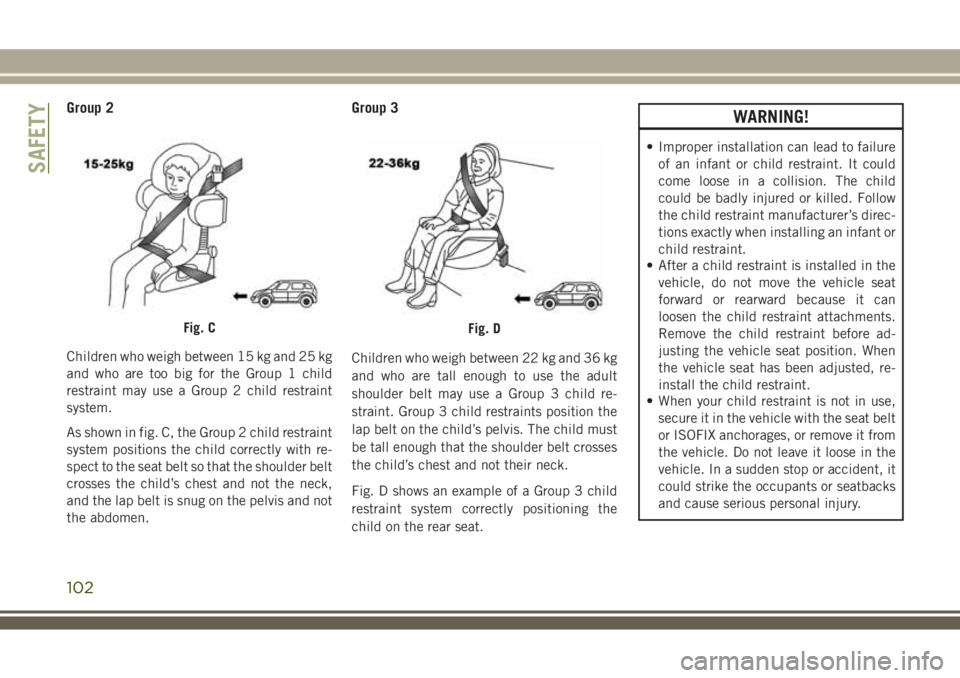
Group 2
Children who weigh between 15 kg and 25 kg
and who are too big for the Group 1 child
restraint may use a Group 2 child restraint
system.
As shown in fig. C, the Group 2 child restraint
system positions the child correctly with re-
spect to the seat belt so that the shoulder belt
crosses the child’s chest and not the neck,
and the lap belt is snug on the pelvis and not
the abdomen.
Group 3
Children who weigh between 22 kg and 36 kg
and who are tall enough to use the adult
shoulder belt may use a Group 3 child re-
straint. Group 3 child restraints position the
lap belt on the child’s pelvis. The child must
be tall enough that the shoulder belt crosses
the child’s chest and not their neck.
Fig. D shows an example of a Group 3 child
restraint system correctly positioning the
child on the rear seat.
WARNING!
• Improper installation can lead to failure
of an infant or child restraint. It could
come loose in a collision. The child
could be badly injured or killed. Follow
the child restraint manufacturer’s direc-
tions exactly when installing an infant or
child restraint.
• After a child restraint is installed in the
vehicle, do not move the vehicle seat
forward or rearward because it can
loosen the child restraint attachments.
Remove the child restraint before ad-
justing the vehicle seat position. When
the vehicle seat has been adjusted, re-
install the child restraint.
• When your child restraint is not in use,
secure it in the vehicle with the seat belt
or ISOFIX anchorages, or remove it from
the vehicle. Do not leave it loose in the
vehicle. In a sudden stop or accident, it
could strike the occupants or seatbacks
and cause serious personal injury.
Fig. CFig. D
SAFETY
102
Page 105 of 276

Suitability of Passenger Seats for Universal
Child Restraint System Use
According to the European Directive 2000/3/
EC, the suitability of each passenger seat
position for the installation of Universal Child
Restraint Systems is shown in the following
table:
2 Door Seating Position
Mass GroupUniversal Child Seating
Position Table
Front
PassengerRear Outboard
0-Upto
10 kgXU
0+-Upto
13 kgXU
I-9to18kg X U
II-15to
25 kgXU
III-22to
36 kgXU
4 Door Seating Position
Mass
GroupUniversal Child Seating
Position Table
Front
PassengerRear
OutboardRear
Center
0-Upto
10 kgXUU
0+-Up
to 13 kgXUU
I-9to
18 kgXUU
II-15to
25 kgXUU
III-22to
36 kgXUU
Key of letters used in the table above:
• U = Suitable for “universal” category re-
straints approved for use in this mass
group.
• X = Seat position not suitable for children
in this mass group.
If the head restraint interferes with the instal-
lation of the child restraint system, adjust the
head restraint(if adjustable).
Seat Belts For Older Children
Children over 1.50 m in height can wear seat
belts instead of using child restraints.
Use this simple 5-step test to decide whether
the seat belt properly fits the child or if they
should still use a Group 2 or Group 3 child
restraint to improve the fit of the seat belt:
1. Can the child sit all the way back against
the back of the vehicle seat?
2. Do the child’s knees bend comfortably
over the front of the vehicle seat – while
they are still sitting all the way back?
3. Does the shoulder belt cross the child’s
shoulder between their neck and arm?
4. Is the lap part of the belt as low as
possible, touching the child’s thighs and
not their stomach?
5. Can the child stay seated like this for the
whole trip?
If the answer to any of these questions was
“no,” then the child still needs to use a Group
2 or 3 child restraint in this vehicle. If the
child is using the lap/shoulder belt, check
belt fit periodically and make sure the seat
103
Page 106 of 276
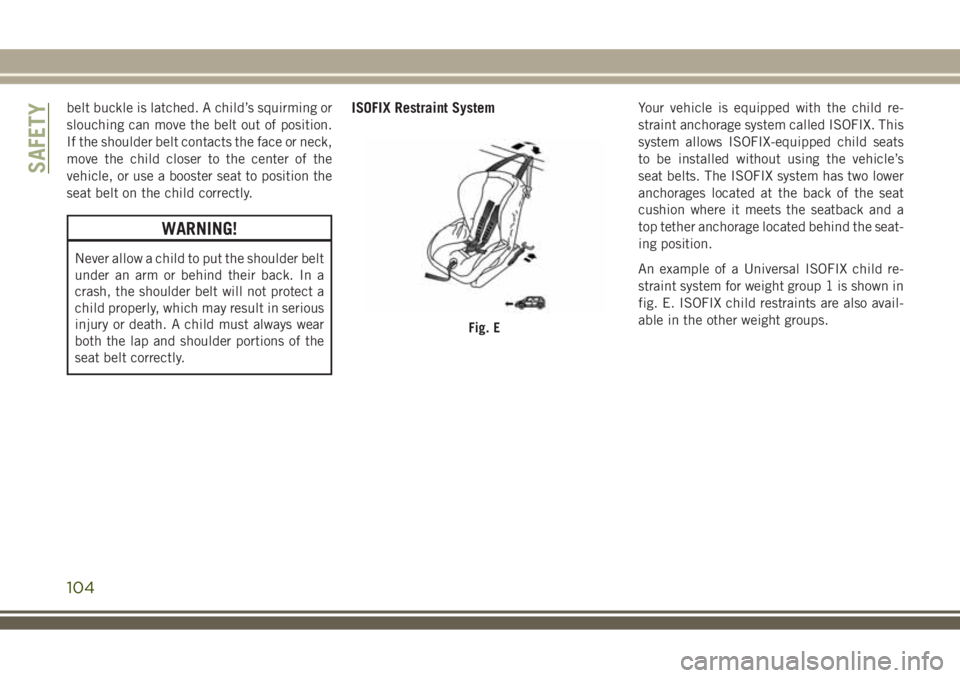
belt buckle is latched. A child’s squirming or
slouching can move the belt out of position.
If the shoulder belt contacts the face or neck,
move the child closer to the center of the
vehicle, or use a booster seat to position the
seat belt on the child correctly.
WARNING!
Never allow a child to put the shoulder belt
under an arm or behind their back. In a
crash, the shoulder belt will not protect a
child properly, which may result in serious
injury or death. A child must always wear
both the lap and shoulder portions of the
seat belt correctly.
ISOFIX Restraint SystemYour vehicle is equipped with the child re-
straint anchorage system called ISOFIX. This
system allows ISOFIX-equipped child seats
to be installed without using the vehicle’s
seat belts. The ISOFIX system has two lower
anchorages located at the back of the seat
cushion where it meets the seatback and a
top tether anchorage located behind the seat-
ing position.
An example of a Universal ISOFIX child re-
straint system for weight group 1 is shown in
fig. E. ISOFIX child restraints are also avail-
able in the other weight groups.
Fig. E
SAFETY
104
Page 107 of 276
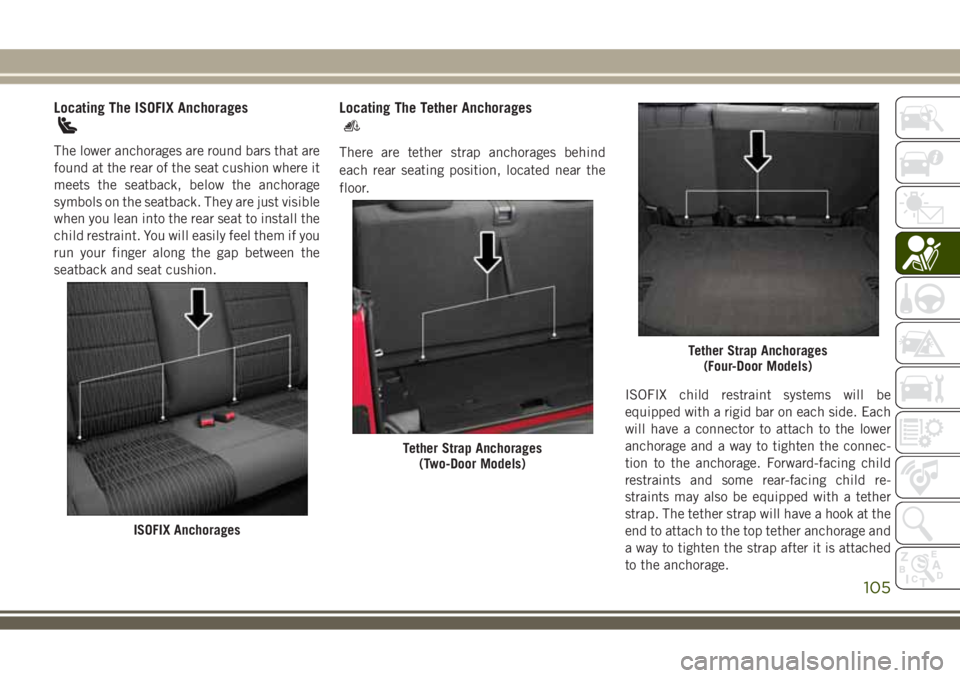
Locating The ISOFIX Anchorages
The lower anchorages are round bars that are
found at the rear of the seat cushion where it
meets the seatback, below the anchorage
symbols on the seatback. They are just visible
when you lean into the rear seat to install the
child restraint. You will easily feel them if you
run your finger along the gap between the
seatback and seat cushion.
Locating The Tether Anchorages
There are tether strap anchorages behind
each rear seating position, located near the
floor.
ISOFIX child restraint systems will be
equipped with a rigid bar on each side. Each
will have a connector to attach to the lower
anchorage and a way to tighten the connec-
tion to the anchorage. Forward-facing child
restraints and some rear-facing child re-
straints may also be equipped with a tether
strap. The tether strap will have a hook at the
end to attach to the top tether anchorage and
a way to tighten the strap after it is attached
to the anchorage.
ISOFIX Anchorages
Tether Strap Anchorages
(Two-Door Models)
Tether Strap Anchorages
(Four-Door Models)
105
Page 108 of 276
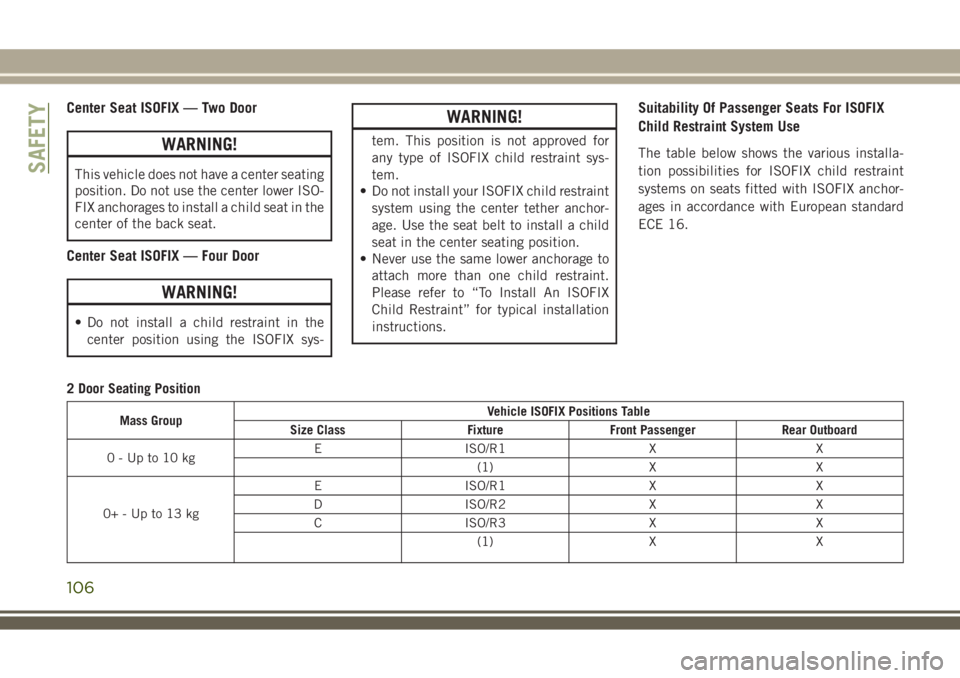
Center Seat ISOFIX — Two Door
WARNING!
This vehicle does not have a center seating
position. Do not use the center lower ISO-
FIX anchorages to install a child seat in the
center of the back seat.
Center Seat ISOFIX — Four Door
WARNING!
• Do not install a child restraint in the
center position using the ISOFIX sys-
WARNING!
tem. This position is not approved for
any type of ISOFIX child restraint sys-
tem.
• Do not install your ISOFIX child restraint
system using the center tether anchor-
age. Use the seat belt to install a child
seat in the center seating position.
• Never use the same lower anchorage to
attach more than one child restraint.
Please refer to “To Install An ISOFIX
Child Restraint” for typical installation
instructions.
Suitability Of Passenger Seats For ISOFIX
Child Restraint System Use
The table below shows the various installa-
tion possibilities for ISOFIX child restraint
systems on seats fitted with ISOFIX anchor-
ages in accordance with European standard
ECE 16.
2 Door Seating Position
Mass GroupVehicle ISOFIX Positions Table
Size Class Fixture Front Passenger Rear Outboard
0-Upto10kgE ISO/R1 X X
(1) X X
0+-Upto13kgE ISO/R1 X X
D ISO/R2 X X
C ISO/R3 X X
(1) X X
SAFETY
106
Page 109 of 276
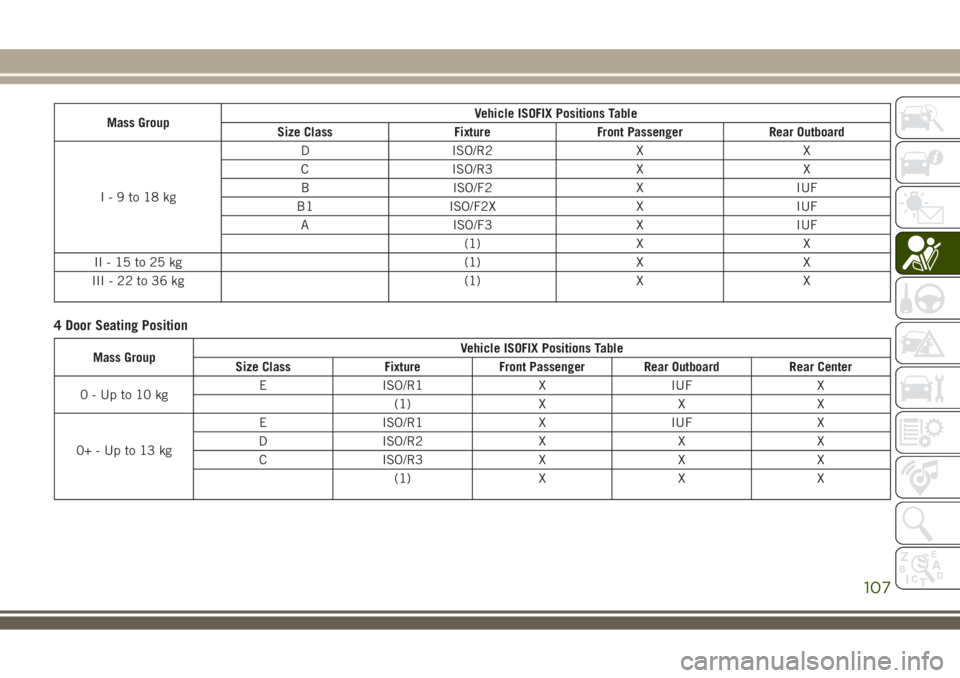
Mass GroupVehicle ISOFIX Positions Table
Size Class Fixture Front Passenger Rear Outboard
I-9to18kgD ISO/R2 X X
C ISO/R3 X X
B ISO/F2 X IUF
B1 ISO/F2X X IUF
A ISO/F3 X IUF
(1) X X
II-15to25kg (1) X X
III-22to36kg (1) X X
4 Door Seating Position
Mass GroupVehicle ISOFIX Positions Table
Size Class Fixture Front Passenger Rear Outboard Rear Center
0-Upto10kgE ISO/R1 X IUF X
(1) X X X
0+-Upto13kgE ISO/R1 X IUF X
D ISO/R2 X X X
C ISO/R3 X X X
(1) X X X
107
Page 110 of 276
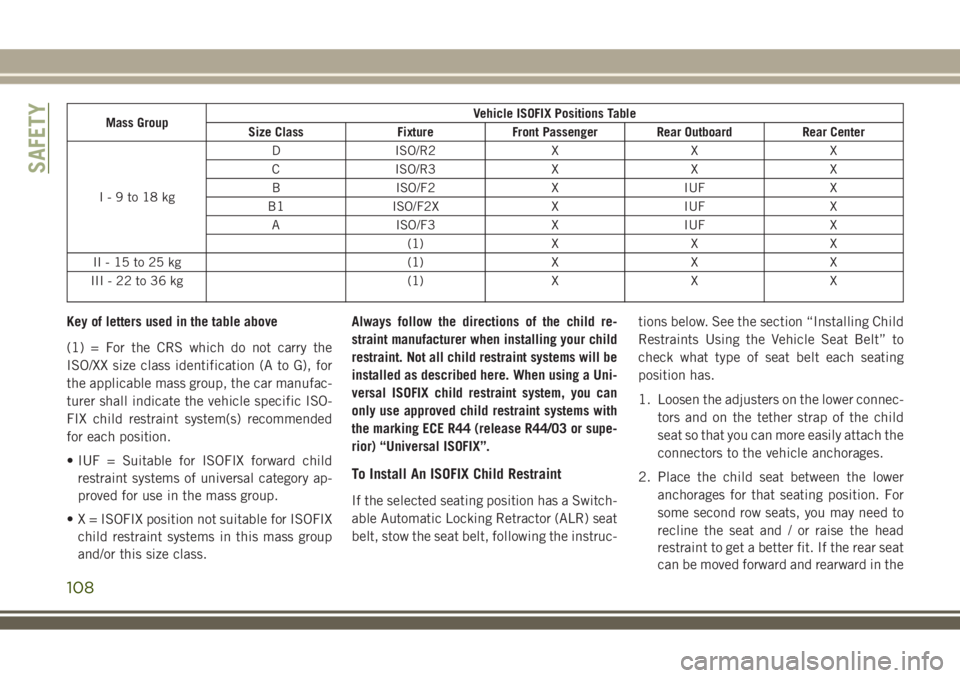
Mass GroupVehicle ISOFIX Positions Table
Size Class Fixture Front Passenger Rear Outboard Rear Center
I-9to18kgD ISO/R2 X X X
C ISO/R3 X X X
B ISO/F2 X IUF X
B1 ISO/F2X X IUF X
A ISO/F3 X IUF X
(1) X X X
II-15to25kg (1) X X X
III-22to36kg (1) X X X
Key of letters used in the table above
(1) = For the CRS which do not carry the
ISO/XX size class identification (A to G), for
the applicable mass group, the car manufac-
turer shall indicate the vehicle specific ISO-
FIX child restraint system(s) recommended
for each position.
• IUF = Suitable for ISOFIX forward child
restraint systems of universal category ap-
proved for use in the mass group.
• X = ISOFIX position not suitable for ISOFIX
child restraint systems in this mass group
and/or this size class.Always follow the directions of the child re-
straint manufacturer when installing your child
restraint. Not all child restraint systems will be
installed as described here. When using a Uni-
versal ISOFIX child restraint system, you can
only use approved child restraint systems with
the marking ECE R44 (release R44/03 or supe-
rior) “Universal ISOFIX”.
To Install An ISOFIX Child Restraint
If the selected seating position has a Switch-
able Automatic Locking Retractor (ALR) seat
belt, stow the seat belt, following the instruc-tions below. See the section “Installing Child
Restraints Using the Vehicle Seat Belt” to
check what type of seat belt each seating
position has.
1. Loosen the adjusters on the lower connec-
tors and on the tether strap of the child
seat so that you can more easily attach the
connectors to the vehicle anchorages.
2. Place the child seat between the lower
anchorages for that seating position. For
some second row seats, you may need to
recline the seat and / or raise the head
restraint to get a better fit. If the rear seat
can be moved forward and rearward in the
SAFETY
108